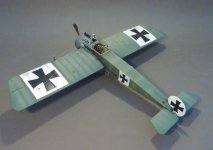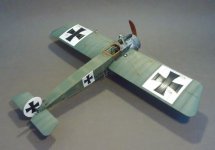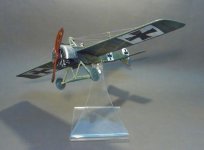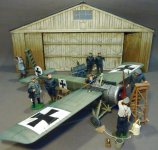KNIGHTS OF THE SKIES
The Fokker E.III was the main variant of the Eindecker (monoplane) fighter aircraft of World War I. It entered service on the Western Front in December 1915 and was also supplied to Austria-Hungary and Turkey.
The E.III was the first type to arrive in sufficient numbers to form small specialist fighter units, Kampfeinsitzer Kommandos (KEK) in early 1916. Previously, Eindeckers had been allocated singly, just as the E.I and E.II had been, to the front-line Feldflieger Abteilungen that carried out reconnaissance duties. On 10 August 1916, the first German Jagdstaffeln (single-seat fighter squadrons) were formed, initially equipped with various early fighter types, including a few E.IIIs, which were by then outmoded and being replaced by more modern fighters. Standardisation in the Jagdstaffeln (and any real success) had to wait for the availability in numbers of the Albatros D.I and Albatros D.II in early 1917.
Fokker production figures state that 249 E.IIIs were manufactured

ACE-23
KNIGHTS OF THE SKIES
FOKKER EIII, 246/16,
MAX IMMELMANN,
KeK Douai, June 1916.
(1pc)
Developed in April 1915, the Eindecker ("Monoplane") was the first purpose-built German fighter aircraft and the first aircraft to be fitted with synchronizer gear, enabling the pilot to fire a machine gun through the arc of the propeller without striking the blades. The Eindecker granted the German Air Service a degree of air superiority from July 1915 until early 1916. This period was known as the "Fokker Scourge," during which Allied aviators regarded their poorly armed aircraft as "Fokker Fodder". The Eindecker was based on Fokker's unarmed A.III scout (itself following very closely the design of the French Morane-Saulnier H shoulder-wing monoplane) which was fitted with a synchronizer mechanism controlling a single Parabellum MG14 machine gun.
Anthony Fokker personally demonstrated the system on 23 May 1915, having towed the prototype aircraft behind his touring car to a military airfield near Berlin.

Max Immelmann scored his first victory flying the “Eindecker.” Scourge of the air during the winter of 1915, the Fokker E.I was the first aircraft armed with a synchronized, forward firing machine gun. German pilots were ordered not to fly it across enemy lines for fear the Allies would capture the secrets of the synchronizing gear. Followed by the E.II, E.III and E.IV, the Eindecker was underpowered and slow but could out turn most of its opponents.
Allied aviators who faced it called themselves “Fokker Fodder” The Eindecker ruled the skies until the Nieuports and SPADs were developed.


**PLEASE CONTACT YOUR LOCAL DEALER FOR FURTHER INFORMATION**
The Fokker E.III was the main variant of the Eindecker (monoplane) fighter aircraft of World War I. It entered service on the Western Front in December 1915 and was also supplied to Austria-Hungary and Turkey.
The E.III was the first type to arrive in sufficient numbers to form small specialist fighter units, Kampfeinsitzer Kommandos (KEK) in early 1916. Previously, Eindeckers had been allocated singly, just as the E.I and E.II had been, to the front-line Feldflieger Abteilungen that carried out reconnaissance duties. On 10 August 1916, the first German Jagdstaffeln (single-seat fighter squadrons) were formed, initially equipped with various early fighter types, including a few E.IIIs, which were by then outmoded and being replaced by more modern fighters. Standardisation in the Jagdstaffeln (and any real success) had to wait for the availability in numbers of the Albatros D.I and Albatros D.II in early 1917.
Fokker production figures state that 249 E.IIIs were manufactured

ACE-23
KNIGHTS OF THE SKIES
FOKKER EIII, 246/16,
MAX IMMELMANN,
KeK Douai, June 1916.
(1pc)
Developed in April 1915, the Eindecker ("Monoplane") was the first purpose-built German fighter aircraft and the first aircraft to be fitted with synchronizer gear, enabling the pilot to fire a machine gun through the arc of the propeller without striking the blades. The Eindecker granted the German Air Service a degree of air superiority from July 1915 until early 1916. This period was known as the "Fokker Scourge," during which Allied aviators regarded their poorly armed aircraft as "Fokker Fodder". The Eindecker was based on Fokker's unarmed A.III scout (itself following very closely the design of the French Morane-Saulnier H shoulder-wing monoplane) which was fitted with a synchronizer mechanism controlling a single Parabellum MG14 machine gun.
Anthony Fokker personally demonstrated the system on 23 May 1915, having towed the prototype aircraft behind his touring car to a military airfield near Berlin.

Max Immelmann scored his first victory flying the “Eindecker.” Scourge of the air during the winter of 1915, the Fokker E.I was the first aircraft armed with a synchronized, forward firing machine gun. German pilots were ordered not to fly it across enemy lines for fear the Allies would capture the secrets of the synchronizing gear. Followed by the E.II, E.III and E.IV, the Eindecker was underpowered and slow but could out turn most of its opponents.
Allied aviators who faced it called themselves “Fokker Fodder” The Eindecker ruled the skies until the Nieuports and SPADs were developed.


**PLEASE CONTACT YOUR LOCAL DEALER FOR FURTHER INFORMATION**

